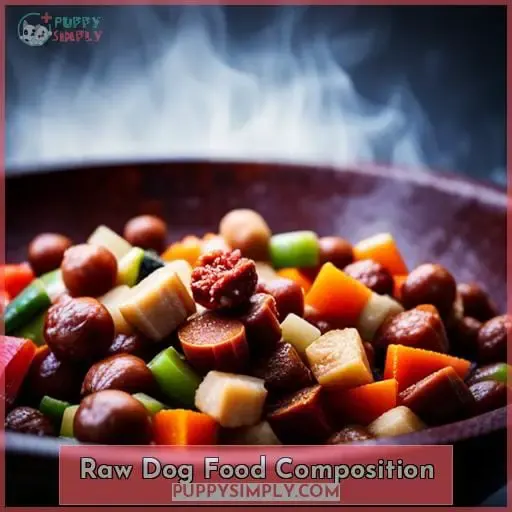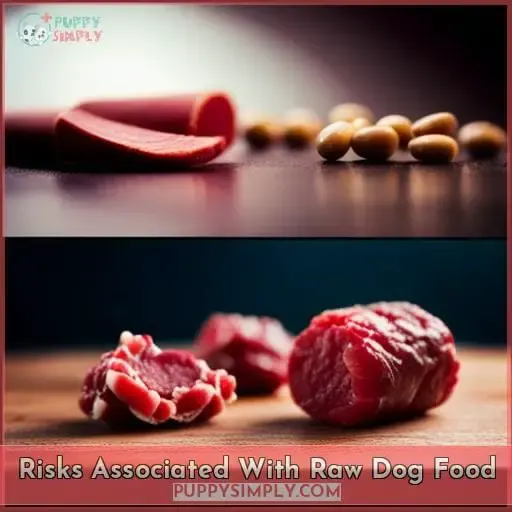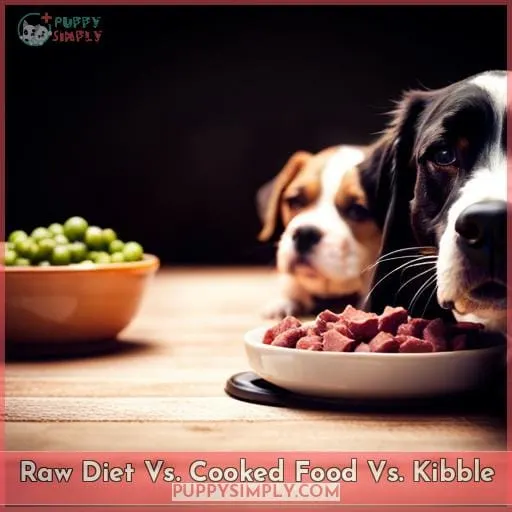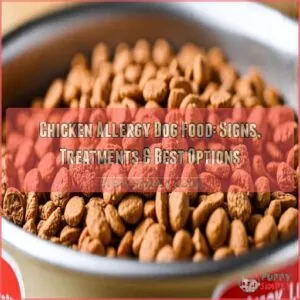This site is supported by our readers. We may earn a commission, at no cost to you, if you purchase through links.
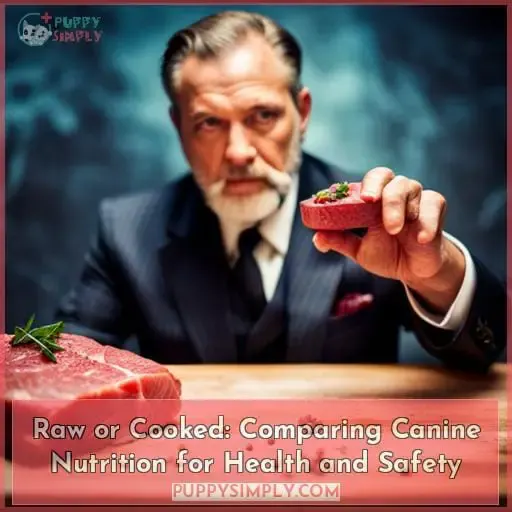 You’re keen to feed your dog the best diet possible – one that energizes yet nourishes.
You’re keen to feed your dog the best diet possible – one that energizes yet nourishes.
When considering raw vs. cooked options, know that gently-cooked, meat-focused whole foods pass rigorous quality checks and digest superbly.
So empower your pup, while safeguarding their health.
Table Of Contents
- Key Takeaways
- Raw Dog Food Composition
- Digestibility of Raw and Cooked Diets Vs. Kibble
- Risks Associated With Raw Dog Food
- Scientific Research and Quality Control
- Fresh Food
- What to Look for in Fresh Food
- Raw Diet Vs. Cooked Food Vs. Kibble
- Frequently Asked Questions (FAQs)
- How expensive is it to feed my dog a raw or cooked fresh food diet compared to kibble?
- What are some easy ways to transition my dog from kibble to a fresh food diet?
- Do dogs on fresh food diets need dietary supplements?
- How do I know if a fresh dog food delivery service is reputable?
- Should older dogs or puppies only eat cooked fresh foods rather than raw?
- Conclusion
Key Takeaways
- Raw dog food risks contaminants and nutrition imbalances; cooking maintains nutrients while eliminating pathogens
- Cooking methods like sous-vide better preserve bioavailable nutrients than extrusion or baking used in kibble
- Ingredient transparency and quality control over sourcing are crucial in evaluating raw brands
- Commercial fresh dog food services address home-cooking challenges but should offer customized plans and real, all-natural ingredients
Raw Dog Food Composition
When considering a raw diet, you must examine the ingredients and their sources closely.
Commercially made raw food may use non-certified or rejected parts, whereas higher-quality brands opt for USDA-approved, human-grade components.
Selecting reputable providers that follow safety and quality standards helps minimize risks associated with raw feeding.
Ingredients in Raw Diets
Two key ingredients in raw dog food diets are uncooked meat from various sources and blended body parts like flesh, organs, and bones.
Raw diets may lack:
- Complete and balanced nutrition
- Proper handling standards
- Quality control over ingredients
Commercially made raw foods often contain non-USDA certified components. Without regulation, nutritional imbalances or contamination could occur.
Recent studies reveal comparable digestibility between raw and gently cooked whole food ingredients.
Emphasizing safety and quality sourcing is key.
Quality and Sourcing of Ingredients
You’ll want transparency regarding the quality and sourcing of ingredients when evaluating raw diets’ composition.
Select brands committed to ethical, USDA-approved sourcing standards that ensure nutritional integrity.
Raw brands lacking transparency around quality assurance and ingredient origins may utilize questionable, unregulated components.
For optimal safety and nutrition, emphasize ingredient transparency and evidence of quality control in any real-food diet, gently cooked or raw.
Brands like JustFoodForDogs openly share their scientific research and standards behind creating balanced diets with premium, meat-focused ingredients.
Digestibility of Raw and Cooked Diets Vs. Kibble
Recent studies show that both raw and cooked whole food diets demonstrate higher digestibility for dogs compared to extruded kibble diets.
Specifically, the protein component in gently cooked and raw diets is more bioavailable and digestible than proteins found in commercial kibble, which tends to incorporate more fillers and by-products that negatively impact digestibility.
Initial research on domestic cats also reveals significantly higher digestibility for most nutrients in raw meat-based diets compared to extruded foods, though no significant difference is yet observed in digestibility between raw and cooked ingredients.
Research on Digestibility
Recent studies show higher digestibility for both raw and cooked diets compared to kibble.
Proteins in raw and cooked diets are more digestible than those in extruded kibble.
Kibble contains fillers and by-products, affecting digestibility.
Studies on domestic cats reveal significantly higher digestibility in raw diets.
No significant difference in digestibility observed between raw and cooked ingredients.
Cooking methods like sous-vide maintain nutrient bioavailability.
Certain breeds may have specialized needs, but research indicates enhanced palatability and digestibility across raw and gently cooked whole food options over highly processed alternatives.
Comparison to Extruded Kibble
Upholding prior analyses, you’re discovering raw and cooked diets don’t differ significantly in digestibility.
Yet, the best kibble consists of fillers compromising breakdown.
The table displays superior digestibility for raw and cooked diets.
Their proteins and fibers enjoy better breakdown with nutrient density prevailing over kibble’s carbs and fillers.
Factoring cost considerations, the data supports homemade or commercial whole food as optimal nutrition.
Risks Associated With Raw Dog Food
When feeding a raw diet, you must be vigilant about potential nutritional imbalances leading to deficiencies or excesses.
There’s also an increased risk of foodborne pathogens from contamination, as commercial raw pet foods may not adhere to proper sourcing and handling standards.
Even slight mishandling of raw ingredients can expose both pets and pet owners to dangerous bacteria like Salmonella or E.
Nutritional Imbalances
In feeding raw, you risk nutritional imbalances from a lack of complete and balanced ingredients.
Without veterinary guidance, homemade raw diets may lack essential nutrients for your dog’s health needs.
Seeking expert consultation ensures properly formulated, fresh, whole food ingredients meet nutritional requirements, avoiding implications of nutrient deficiencies or toxicity.
Pathogen Contamination
You’re also facing potential contamination with pathogens in raw meat, including Salmonella and E.
Improper thawing techniques may lead to bacterial growth.
Leftovers require careful handling and prompt disposal.
Rigorous cleaning of all surfaces is crucial for household hygiene.
Handling Standards
When preparing raw diets, you’ll need to adhere to precise safety protocols to avoid contaminating the ingredients or your home.
Strict hygiene and handling practices are critical, including using separate prep surfaces and utensils.
Meticulously follow all safety measures for thawing, preparing, and storing to prevent pathogen growth.
Carefully dispose of uneaten food promptly.
Consult experts on standards for supplying balanced, high-quality nutrition safely.
Scientific Research and Quality Control
When examining the differences between raw and cooked canine diets, you should prioritize brands basing decisions on scientific research and committed to quality control, like JustFoodForDogs.
Their balanced, freshly prepared meals use lightly cooked whole foods and human-grade ingredients from USDA-certified sources to ensure safety and nutrition.
JustFoodForDogs’ diets undergo extensive feeding trials and meet NRC nutritional recommendations for complete, balanced nutrition.
JustFoodForDogs Approach
As mentioned, you’re basing nutrition decisions on scientific research to align with a mission of balanced, freshly prepared, lightly cooked whole food using USDA-certified, human-grade ingredients.
- Commitment to quality control and premium ingredients.
- Human-grade sources ensure safety.
- Diets undergo feeding trials.
- Complete, balanced, meeting NRC recommendations.
- Focus on digestibility insights from research.
Commitment to Quality and Safety
You commit to scientific research and stringent quality control measures.
- Undergoing feeding trials to formulate complete, balanced diets that align with your mission of providing safe, lightly cooked whole foods.
- Ingredient transparency and adherence to the highest safety standards ensure nutritional integrity.
- Our quality assurance protocols verify nutritional claims through veterinary research on balanced, whole food diets to eliminate potential GI injury risks.
| Ingredient Transparency | Quality Assurance | Safety Standards |
|---|---|---|
| Verified Sources | Feeding Trials | Pathogen Testing |
| Published Formulas | Veterinary Oversight | Food Safety Certification |
| Full Ingredient Listing | Laboratory Analysis | Safe Handling Standards |
Feeding Trials and Balanced Nutrition
You’ll find JustFoodForDogs conducts feeding trials and formulates diets that meet NRC recommendations for complete and balanced canine nutrition.
Rigorous canine nutrition trials inform recipes.
Insights from digestibility studies optimize ingredients.
Meticulous protocols eliminate handling hazards.
Balanced, real-food diets promote optimal health.
Fresh Food
When considering fresh food options for your dog, focus first on:
- Characteristics of real, whole ingredients
- Potential benefits
Also carefully evaluate challenges with the cooking process itself regarding:
- Time
- Space
- Financial constraints on preparing homemade food
Commercial fresh dog food delivery services may help address some of these challenges through:
- Customized, nutritionist-designed plans
- All natural, quality controlled ingredients
Characteristics and Benefits of Fresh Food
After reviewing the scientific research and quality control upholding premium brands, you’d discover that fresh food boasts natural, real ingredients promoting dogs’ overall well-being like heart health, increased energy, shiny coats, improved breath, and better eyesight.
However, fresh food does present cooking challenges regarding time, space, and finances, and homemade diets lack nutritional scrutiny that companies aim to provide through veterinary collaboration on balanced, personalized formulas using transparent, reputable ingredients.
Challenges of Cooking Process
However, cooking fresh dog food at home can be challenging in terms of time, space, and finances. Furthermore, homemade diets lack the scrutiny of commercial options regarding balanced nutrition.
Preparing fresh meals demands significant time management to shop, prep ingredients, and cook recipes. You’ll also need adequate cooking space and likely encounter financial constraints purchasing quality ingredients.
Unlike commercial dog food meeting nutritional standards, homemade diets evade similar scrutiny, presenting potential feeding challenges.
What to Look for in Fresh Food
When exploring fresh food options for your dog, seek out subscription-based services that offer customized plans.
These plans allow you to select:
- Recipe choices
- Portion sizes
- Delivery frequency
Base your selections on your dog’s unique needs.
Also, look for transparency from the provider on:
- Their ingredients
- Feeding guidance schedules
- Tips on maintaining freshness of the meals, whether raw or cooked
Reputable fresh food providers should also carry all-natural, single-ingredient treats without any fillers or artificial additives.
Considerations for Personalized Plans
You’re often looking for subscription-based services offering customized feeding plans based on your dog’s specific needs.
These services include options for recipe choices, ideal portion sizes, and delivery frequency.
Seek out brands providing individualized plans tailored to your dog’s weight, breed, age, activity level, and any allergies or health conditions requiring specialized nutrition.
Prioritize transparency in ingredients and formulas to ensure balanced, personalized feeding.
Transparency in Ingredients and Freshness
You’ll want to look for transparent information on:
- The ingredients used,
- Feeding schedules to maintain freshness, and
- Processes ensuring the quality and safety of the food.
Select services that provide clear details on:
- All ingredients and their sourcing,
- Along with guidance on proper storage and feeding based on your dog’s needs.
This nutritional clarity and quality verification brings confidence in the safety of both raw and gently cooked whole food options.
All-natural, Single-ingredient Treats
When selecting treats, you should always opt for all-natural, single-ingredient options without any fillers or artificial additives.
- Wholesome proteins (chicken, beef, fish)
- Vitamin-rich fruits and veggies
- Healthy fats (salmon oil, coconut oil)
These tasty bites offer canine rewards through raw, cooked, or dehydrated preparations for good gut health.
Wholesome goodies provide natural delights dogs crave.
Raw Diet Vs. Cooked Food Vs. Kibble
Comparing Canine Nutrition for Health and Safety:
When considering the best dietary options for your dog, you’ll need to weigh the potential benefits and risks of raw food, cooked food, and kibble.
Factors like nutritional balance, digestibility, safety, and your own constraints and preferences should guide your decision between these feeding choices.
Consulting your veterinarian can provide helpful advice tailored to your dog’s individual dietary needs and health conditions.
Comparison of Different Feeding Options
How might you weigh the risks and benefits of a raw diet, gently cooked food, or kibble when considering your dog’s nutritional needs?
Assess flavor preferences and canine digestion of various proteins.
Balance omega-3s for skin and coat health.
Calculate pathogen risks of raw ingredients and research handling protocols.
Evaluate nutritional soundness across prepared recipes.
Finally, factor owner satisfaction, including convenience, before determining the optimal fresh or extruded diet.
| Consideration | Raw | Cooked | Kibble |
|---|---|---|---|
| Flavor | Stronger aroma | Enhanced taste | Blandness |
| Digestion | More bioavailable | Still digestible | Less digestible |
| Satisfaction | Perceived health | Enjoyment | Convenience |
| Risks | Contamination | Minimal | Low |
Owner Considerations and Preferences
You’re factoring time, space, and financial constraints when choosing between the raw versus cooked decision-making around your dog’s nutritional needs.
Considerations include:
- Cost considerations
- Time constraints
- Taste preferences
Health concerns like allergies and your dog’s activity levels also play a role, as do lifestyle factors like your ability to adhere to specialized feeding schedules.
Getting input from your vet and reading reviews of fresh food delivery services like Ollie can further inform nutrition decisions.
Frequently Asked Questions (FAQs)
How expensive is it to feed my dog a raw or cooked fresh food diet compared to kibble?
Fresh cooked or raw diets tend to cost more than kibble.
There are some ways to mitigate the price difference if you value the potential benefits.
With a little effort to find quality ingredients affordably and prepare meals efficiently at home, feeding fresh can work within many budgets.
What are some easy ways to transition my dog from kibble to a fresh food diet?
Transitioning your canine companion to a fresh food diet is a walk in the park!
Just start by mixing a smidgen of the delectable fresh food with their regular kibble.
Gradually increase the fresh food ratio over a week.
Voila! Your furry friend will be savoring the symphony of flavors in no time.
Do dogs on fresh food diets need dietary supplements?
Fresh food diets for dogs are typically formulated to provide complete and balanced nutrition without supplements.
However, check with your veterinarian, as some dogs may benefit from additional vitamins or minerals based on their age, breed, or unique needs.
Regular lab work can confirm your dog is getting everything they need from their diet.
How do I know if a fresh dog food delivery service is reputable?
When selecting a fresh dog food service, prioritize those using human-grade, USDA-certified ingredients.
Reputable companies clearly display this certification and have veterinary nutritionists creating recipes tailored to your dog’s needs.
Transparency regarding sourcing and preparation methods indicates reliability.
Should older dogs or puppies only eat cooked fresh foods rather than raw?
There is insufficient evidence to definitively recommend cooked over raw diets for all puppies and senior dogs.
Consult your veterinarian about the potential benefits and risks of various feeding options given your pet’s unique needs and environment.
Fresh, whole foods can provide quality nutrition when properly handled.
Conclusion
Considering over 60% of commercial dog food is compromised of anonymous ingredients, you should feel empowered to provide your pup personalized nutrition.
By understanding the unique merits of raw versus gently-cooked, meat-focused diets, you can confidently nourish your dog’s health – feeding them recognizable, quality ingredients tailored to their needs.
Ultimately, an evidence-based approach focused on digestibility, safety, and transparency allows you to make the optimal decision when comparing canine diets.

